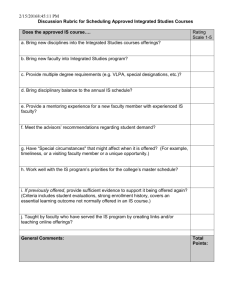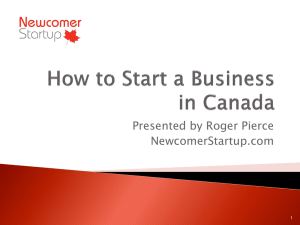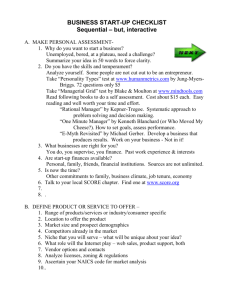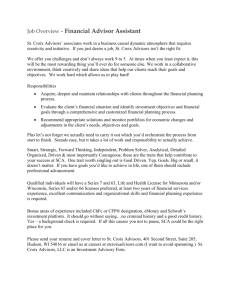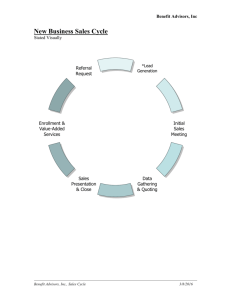Test the market's state of readiness
advertisement
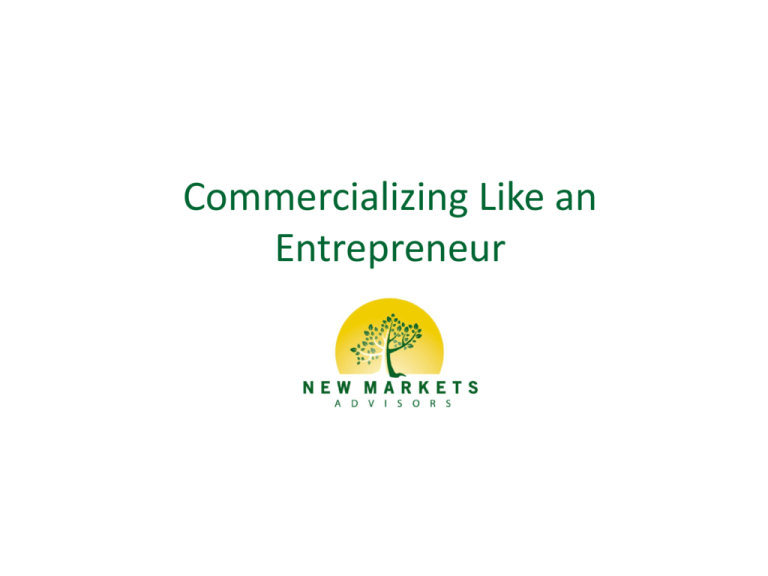
Commercializing Like an Entrepreneur Taking products and services to market requires patience and detailed planning • The most common problems in the way of commercialization are: (1) a failure to understand a market completely and (2) a reversion to core company processes – Companies often follow preexisting paths to launch, careless to consider the true market, how fast it is growing, and the right channel and time for entry • If you approach commercialization like an entrepreneur, you are better positioned to understand the dynamics of the marketplace, and therefore to introduce your offering most strategically Source: New Markets analysis Copyright 2013 New Markets Advisors 2 1. Assess the true market for your offering • Determine who is already playing in the field – Established companies vs. startups? – High volume of acquisitions / partnerships? – Existing companies are profitable? • Expand the field – Determine whether other companies, products, services, and processes are solving the underlying jobs that consumers are looking to accomplish Example: Automobile manufacturer Target consumers’ latent needs: • Express myself • Park in tight spaces • Show my ecological sense • Have fun Competition? – Look beyond traditional actors in the field • Assess your organization’s competencies and weaknesses – Determine what portion of the market your organization can realistically play in – Instead of looking at competitors in static terms, look at them in terms of flexibility and motivations Source: New Markets analysis Copyright 2013 New Markets Advisors 3 2. Find market size estimates and test the market’s state of readiness • Find market size estimates – Review industry publications to generate a range of market potential – Carefully consider how each estimate defines the market – Determine how broad / narrow your target market is in comparison to estimated markets • Test the market’s state of readiness – Assess the success / failure of similar launches – Interview early adopters – Consider mini pilot launches and concept tests – Look at hype cycle projections Source: New Markets analysis; Gartner, Inc. Copyright 2013 New Markets Advisors 4 3. Review the assumptions checklist to catch dangerous assumptions before they hurt you • • • • Assumptions about the business model • Assumptions about manufacturing and production – Cost, assets, profit model, and timing – Ability to control product costs and quality – Major obstacles and feasibility of breaking through them – Service requirements and cost – Ability to produce at required scale – Availability of people with required knowledge and skills Assumptions about the market – Who will buy and why – quantity, continuity, and frequency – How different market segments will behave – Market growth rate – Development time and cost – Cost and time to achieve target volume or share – Cash required to reach cash breakeven – Distribution channels and access to them – Daily, weekly, monthly breakeven – Price, product, functionality, service, marketing strategy – Breakdown of the numbers into actionable pieces – Investment required for profit-and-loss breakeven, to reach profit objectives – Gross and net margins – Time required to achieve the above – Costs, profit and loss, at varying volume levels Assumptions about developing the product / service – Development time and cost – Functional characteristics related to market need Assumptions about competition – Advantage compared with competitive products – Duration of product advantages – Type of competition that will be faced – Likely competitive response Source: Rita Gunther McGrath and Ian C. MacMillan. Discovery-Driven Growth – A Breakthrough Process to Reduce Risk and Seize Opportunity, 2009 Copyright 2013 New Markets Advisors • Financial assumptions 5 4. Judge how fast the market can grow – drivers of fast market growth Few dependencies • Business infrastructure – reliance on partners may cause delay • Physical infrastructure – reliance on physical assets (e.g., pharmacies with rooms for detailed patient consults) can cause slow roll-out • Few decision makers – agreement from too many people can slow progress Relative advantage • • Need and performance – new offerings should excel over competitors along important dimensions Little behavior change – overcoming social norms is a timeconsuming endeavor Source: Stephen Wunker. Capturing New Markets -- How Smart Companies Create Opportunities Others Don't, 2011 Copyright 2013 New Markets Advisors Low perceived risk • Speedy sales and use – customers should be able to trial quickly and see benefits in action • Low switching cost – there should be low barriers to customer adoption • Low cost of failure – the potential benefits should outweigh the risk of failure Took centuries to catch on Caught on within 5 years 6 5. Choose between two channels to market vs. Superhighway • If a company is going to wellestablished destinations, selling recognized products to easily identifiable customers with a business model that makes sense to the channel, then this is the best option Country Road • For many new markets, the shape of the industry is unclear, there is no ecosystem of firms to provide the full range of services needed, and sales channels have not yet figured out how to profit from the innovation Source: Wunker, 2011 Copyright 2013 New Markets Advisors 7 Examples – channel strategies • • • • • When Walgreens wanted to use its thousands of pharmacists and nurse practitioners to provide face-to-face counseling diabetics, it did not sell the service directly to afflicted patients Health insurers had much to gain from helping people improve diet, exercise, and medication adherence, and people expected to be covered by insurance Walgreens had well-established relationships with insurers Walgreens partnered with UnitedHealthcare to pilot the program The offering created a new market, but everyone understood the customers, stakeholders, and business model • • Flytxt created a technology to hold automated “conversations” via text messaging, generating ideas for marketing campaigns, procuring text messages at bulk rates from cell phone networks, and selling its services directly to companies with brands to build Because Flytxyt did just about everything in this industry’s nascent “value chain,” it had the flexibility to adjust its strategy rapidly - • • Example: As demand took off from radio stations wanting to provide their listeners with a way to text their requests, it could create an interface for DJs to view messages The company had no critical business partners to alienate with these fast shifts It did not need to negotiate to make offerings possible Source: Wunker, 2011 Copyright 2013 New Markets Advisors 8 Choosing the right channel Circumstance Favoring Superhighway Favoring Country Road Customer Need A specific buyer both recognizes the need and has the responsibility for addressing it The marketplace requires education about its need or the buyer’s identity is unclear initially Business Ecosystem A ready-made network of firms exists to service the new market and provide complementary offerings Few partners exist to complement the firm in providing a full solution for customers’ needs Rate of Market If the market is unlikely to change rapidly, a Change superhighway can allow fast scaling of the business If the market is likely to remain in flux, a country road can provide more flexibility for changing the route Advantages to Scale In industries with high fixed costs and large advantages to scale, a superhighway can be the fastest route to growth In industries with fewer scale economies, country roads allow firms to find the right formula for success before they start to accelerate growth Exit Strategy For a venture capital-backed startup or other companies seeking to sell themselves relatively quickly, superhighways can plug the company into a network of firms that might be motivated to buy the company to complement existing offerings For companies with longer time horizons, country roads can provide the flexibility to find the right market niche and the ability to develop a range of assets (e.g. technology, sales force) that might prove interesting to buyers Source: Stephen Wunker. “Achieving Growth by Setting New Strategies for New Markets.” Ivey Business Journal, Dec. 2011 Copyright 2013 New Markets Advisors 9 6. Consider whether or not targeting footholds is the best way to enter the market • Initially small footholds (customer segments that are well-defined, easy to please, and able to introduce a product to a larger population) can yield large, highly profitable markets after unique offerings gain traction • You must consider to whom the attributes of your product or service appeal, and if this crowd will enable its popularization and adoption by a larger pool of customers • Gatorade got its start as a solution to fluid and electrolyte loss by football players (the “Gators”) at the University of Florida • Supposedly, after the Gators started winning more games, even winning the Orange Bowl in 1966, football coaches across the country demanded the drink for their players • A few years later, Gatorade was introduced in the NFL • Almost 50 years later, we now recognize Gatorade as a mainstream sports drink Source: Stephen Wunker. “A Foothold Market – In Rickshaws.” Forbes, Jan. 2012 Copyright 2013 New Markets Advisors 10 The value of footholds Speed Footholds enable rapid decision making, accelerate early sales, and focus resources Scalability The benefits of scale can be recognized quickly in new markets by attaining scale within a narrow group of consumers Reference Customers Competitor Signaling The diffusion of innovation is dependent on reference customers – the early adopters who spread the virtues of a new offering to the larger population Becoming known for something in a foothold market sends a strong signal to competitors to “back off,” at least with respect to that segment Source: Stephen Wunker.“Getting Big by Targeting Small.” Ivey Business Journal, 2012 Copyright 2013 New Markets Advisors 11 7. Don’t be too hasty to launch – evaluate the right time to enter the market It is better to be an early mover when a company can: It is better to be an fast follower when a company can: • • Tightly focus on a poorly-served market • Follow a different path than an early mover • Leverage a distinct, preexisting network to use the offering and spread the word Preserve an early market lead stemming from barriers that later entrants will face • Avoid becoming locked into inappropriate technologies or business models before the market is deeply understood • Avoid incurring large upfront costs because it is early to market Sometimes it pays to be an early mover… Source: Stephen Wunker. “Better Growth Decisions: Early Mover, Fast Follower, or Late Follower?” Strategy & Leadership, 2012 Copyright 2013 New Markets Advisors …and sometimes it is better to be a fast follower 12 Funding initiatives – expect variability • In well-established businesses, spreadsheets rule decisions about funding – the potential profitability of investments determines where the money flows • New markets should be treated differently, but often are not – You cannot budget a venture with speculative revenue the same way as predictable estimates for holdings a company has owned for years • An effective method to evaluate necessary funding should reflect how an asset manager would evaluate high-risk holdings – Have a plan for how much will be allocated to the assets each year and a targeted rate of return on those investments – However, know that any one investment will deviate significantly from the target • Key: have enough investments so that variability is neutralized • Because this method budgets based on real costs instead of fictional revenues, it does not overfund ventures Source: New Markets analysis Copyright 2013 New Markets Advisors 13 Funding – expect variability (cont.) • A VC will ask how much is needed to finance the company until its next funding round, which is usually associated with a major milestone in the company’s development (such as its first customer) • This approach concentrates the company on that milestone, avoiding distraction from other actions the company will need to undertake, but which matter little when it comes to meeting the immediate goal • Keeps investments manageably small so that it can spread its bets • It is also key to plan funding looking at steady-state innovation pipeline – Many initiatives obtain funding in the short term, subsequently lacking human resources and budget in the longer term • Shell GameChanger funding - $25,000 for testing of initial ideas - $100,000-$500,000 for ideas in development - (Not responsible for implementation funds) Source: New Markets analysis; Company interviews Copyright 2013 New Markets Advisors 14 Ultimately, be prepared to reevaluate and adapt your approach based on market signals • Responsiveness to signals of change differentiates successful companies from unsuccessful ones • The best ways to stay flexible: – – – – – – – – – – Define markets broadly Create demand before eliminating competitors Leverage the power of platforms to enable innovations Keep pricing flexible – avoid being too transparent Invest in scenarios, not plans Keep fixed costs low Focus on small footholds Consider “country roads” as well as the “superhighway” Base strategy on timing Sequence risks Source: Stephen Wunker. Capturing New Markets -- How Smart Companies Create Opportunities Others Don't, 2011 Copyright 2013 New Markets Advisors 15 Relevant services from New Markets Light-touch counsel on strategy-shaping process Deeper involvement in strategy and solution creation Structuring of primary research and interpretation of results Business plan creation Guidance through paths to commercialization Copyright 2013 New Markets Advisors 16 Who is New Markets? • Experts in reframing market space and generating growth • Senior experience • Creative and pragmatic • First-class consultants, thought leaders, and entrepreneurs Copyright 2013 New Markets Advisors Recent Clients 17 Our team’s publications have appeared in: Copyright 2013 New Markets Advisors 18 Contact Stephen Wunker Managing Director New Markets Advisors 245 First Street, 18th Floor Cambridge, MA 02142 USA Tel. +1 617 337 3060 Fax +1 617 337 3070 swunker@newmarketsadvisors.com Copyright 2013 New Markets Advisors 19
